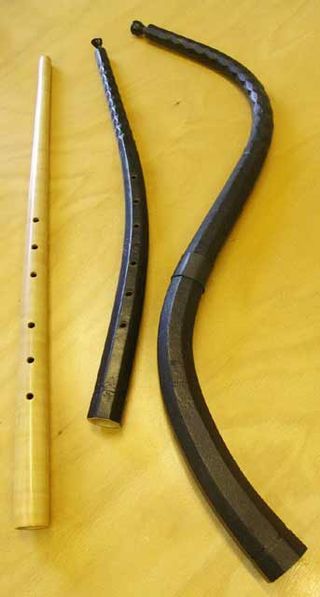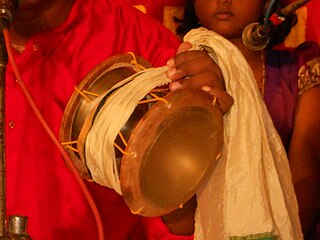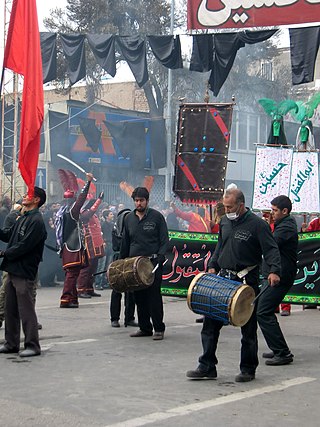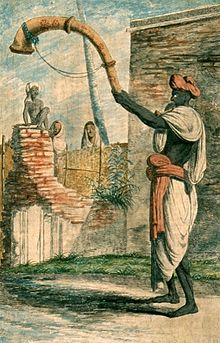
The cornett, cornetto, or zink is a wind instrument that dates from the Medieval, Renaissance and Baroque periods, popular from 1500 to 1650.

The word lituus originally meant a curved augural staff, or a curved war-trumpet in the ancient Latin language. This Latin word continued in use through the 18th century as an alternative to the vernacular names of various musical instruments.

The buisine and the añafil were variations of a type of straight medieval trumpet usually made of metal, also called a herald's trumpet. While arguably the same instrument, the two names represent two separate traditions, in which a Persian-Arabic-Turkic instrument called the Nafir entered European culture in different places and times.

The music of Himachal Pradesh includes many kinds of folk songs from the area, many of which are sung without accompaniment.

Indian folk music is diverse because of India's enormous cultural diversity. It is sung in various languages and dialects throughout the length and breadth of this vast nation and exported to different parts of the world owing to migration.
The sornā or sornāy is an ancient Iranian woodwind instrument.

The Panche baja' is a set of five traditional Nepali musical instruments that are played during holy ceremonies, especially marriages. Panche bajas are usually played by the Damai and the Gaine castes in the Hindu tradition. They are played using the rhythm of folk Nepali songs. It is named as Panchje Baja because in Nepali panch means 5 and the set includes five different types of instruments and baaja means musical instruments.
The chromatic trumpet of Western tradition is a fairly recent invention, but primitive trumpets of one form or another have been in existence for millennia; some of the predecessors of the modern instrument are now known to date back to the Neolithic era. The earliest of these primordial trumpets were adapted from animal horns and sea shells, and were common throughout Europe, Africa, India and, to a lesser extent, the Middle East. Primitive trumpets eventually found their way to most parts of the globe, though even today indigenous varieties are quite rare in the Americas, the Far East and South-East Asia. Some species of primitive trumpets can still be found in remote places, where they have remained largely untouched by the passage of time.
A clapper is a basic form of percussion instrument. It consists of two long solid pieces that are struck together producing sound. They exist in many forms in many different cultures around the world. Clappers can take a number of forms and be made of a wide variety of material. Wood is most common, but metal and ivory have also been used. The plastic thundersticks that have recently come to be popular at sporting events can be considered a form of inflated plastic clapper.

The udukkai, udukai or udukku is a member of the family of membranophone percussion instruments of India and Nepal used in folk music and prayers in Tamil Nadu. The drums are an ancient design of hourglass drums similar to the northern damaru and southern idakka. Its shape is similar to other Indian hourglass drums, having a small snare stretched over one side. They are played with the bare hand, and the pitch may be tered by squeezing the lacing in the middle. It is made of wood or brass and is very portable. It originated in Tamil Nadu as well. Other members in the family include thehuruk, hurkî, hurko, hudko or hudka, utukkai.

The karna or karnay is a metal natural trumpet. The name is first mentioned in the biblical book of Daniel, used in the Middle Ages to the Persian military bands and in the Indian Mughal Empire to the representative orchestra naqqāra-khāna and which is still used by this name in ceremonial music in Central Asia and northern India.
The medieval lituus was a musical instrument of an indeterminate nature, known only from records which ascribe it various properties. Johann Sebastian Bach's O Jesu Christ, Meins Lebens Licht contains the only known piece of music written for an instrument under this name.

The Sringa, also known as tutari, ranasringa, blowhorn, sig, singa, kurudutu, gaali-kommu or kombu, is an ancient Indian musical instrument. It is a type of horn wind instrument.
The mashak is a type of bagpipe found in Northern India, Uttarakhand, Sudurpaschim Province of Nepal and parts of Pakistan and Afghanistan. The pipe was associated with weddings and festive occasions. In India it is historically found in Kumaon and Garhwal in Uttarakhand, Rajasthan and Uttar Pradesh. This bagpipe uses single reeds, and can be played either as a drone or as a melody instrument.

The karnal (Nepali:कर्नाल) is a large, straight brass trumpet, over a metre long, played in parts of Northern India and Nepal. It has a prominent bell resembling a datura flower. It is used on ceremonial occasions, such as the processions of village deities. It is often included among the five instruments of the Nepali pancai baja ensemble.
Musafir Ram Bhardwaj is a paun mata musical instrument player from Himachal Pradesh, India. He was awarded the Padma Shri in 2014.

A horn is any of a family of musical instruments made of a tube, usually made of metal and often curved in various ways, with one narrow end into which the musician blows, and a wide end from which sound emerges. In horns, unlike some other brass instruments such as the trumpet, the bore gradually increases in width through most of its length—that is to say, it is conical rather than cylindrical. In jazz and popular-music contexts, the word may be used loosely to refer to any wind instrument, and a section of brass or woodwind instruments, or a mixture of the two, is called a horn section in these contexts.

The Dammam is a large double-headed cylinder drum or frame drum played by Shias in Iraq and Iran in religious ceremonies. The dammām is usually struck with the left hand and a curved stick in the right hand, especially during passion plays in the mourning month of Muharram or to wake up the devotees early in the morning of Ramadan.

Nafir, also nfīr, plural anfār, Turkish nefir, is a slender shrill-sounding straight natural trumpet with a cylindrical tube and a conical metal bell, producing one or two notes. It was used as a military signaling instrument and as a ceremonial instrument in countries shaped by Islamic culture in North Africa, the Middle East and South Asia. In Ottoman, Persian and Mugulin miniatures, the nafīr is depicted in battle scenes. In Christian culture, it displaced or was played alongside of the curved tuba or horn, as seen in artwork of about the 14th century A.D.















